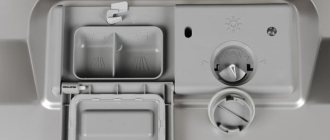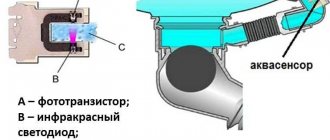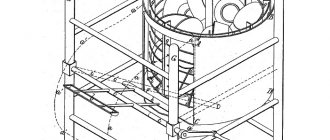The dishwasher is gradually moving from the category of luxury items to standard equipment in the kitchen space. Today there are many variations of this unit on the market, both built-in and free-standing. However, for most manufacturers, the design of the dishwasher (DMM) is no different in terms of the list of parts and components. The difference may be in additional functions and options, adding which manufacturers are trying to attract buyers.
Main components of a dishwasher
The design of any dishwasher consists of the following components.
- Control block.
- Control panel with display. Allows you to perform all the necessary equipment settings.
- Water sprinklers. As a rule, most machines have upper and lower versions.
- Inner chamber. It contains baskets for dishes and the entire washing process takes place.
- A filter that purifies the water supplied to the device.
- Waste water filter. Necessary for retaining food debris.
- Sensors that monitor the temperature and liquid level inside the sink.
- Instantaneous type water heater.
- Ion exchanger. The resin contained in it allows you to soften too hard water.
- A circulation pump that supplies water to the washing chamber.
- A sump pump that discharges wastewater into the sewer system.
In addition, some modern models are equipped with a heat exchanger and a fan for faster drying of dishes.
The chamber for dishes is made of stainless steel. This allows for greater durability of the equipment. In addition, machines can wash not only plates, but also larger dishes - pots and pans. This is why the trays are made removable. The hatch cover of any model of equipment has a rubber seal along the contour, ensuring tightness and reducing noise levels. There is also a container for detergent on it. In modern machines, the use of powder, tablets or liquid formulations is allowed.
Scheme of work
After filling the trays with dishes and loading the cleaning agent and rinse aid into the tanks, the machine is ready to start. The user needs to close the door and turn on the selected program. Water flows to the pump through hoses connected to the main water pipe. The dishwasher circuit includes a safety valve installed at the inlet of the liquid softening unit. Water saturated with salt ions enters the storage cavity located on the bottom of the washing chamber.
The tank design includes a sensor that turns on a shut-off valve after reaching the programmed water level. Then the heating element is activated, which warms the liquid to the temperature specified in the selected program. Warm liquid is pumped by a vane pump into the channels leading to the spray nozzles. The pump impeller creates pressure to ensure uniform distribution of liquid throughout the washing chamber. To improve atomization, rotating rocker arms with nozzles at the ends of the blades are used.
Water flows down the dishes placed on the trays; in parallel, the liquid enters the automatically opening tray with the cleaning agent and dissolves the reagent. The solution flows back into the water reservoir, the channel is equipped with a 3-stage filter that separates fat and food particles. Then the liquid is again supplied to the surface of the dish. After the washing phase is completed, the pump pumps a mixture of water and cleaning agent into the drain.
Clean water flows into the water tank, which is used to remove residual soap solution. Rinse aid is automatically added to the liquid (the dose of the reagent is pre-regulated by the user). The water is heated by a built-in heater or remains cold (depending on the selected algorithm). This operating principle is standard for all Bosch dishwashers. After washing the dishes, the unit for removing residual moisture is activated (condensation or forced - with hot air supplied by an electric fan).
Options for drying dishes in the dishwasher
Currently, a drying mode is provided in almost all models. The only exceptions are the most budget cars. In other cases, drying dishes is carried out in the following ways:
- using a heat exchanger (condensing);
- heated coil and fan (turboblowing);
- zeolite block.
The heat exchanger is a plastic container with cold water inside. Here the principle of operation is based on the fact that after washing the dishes, all remaining water evaporates and settles in the form of condensation on the surface of this block. Of course, this drying method takes a lot of time, but it does not require any energy consumption.
Using a fan will dry dishes much faster. However, this method is energy-consuming. In addition, when choosing a machine, you need to pay attention to the sealing ring of the hatch cover. It should not only prevent leaks, but also help reduce the noise level when the fan operates.
The third method is the most modern and is not yet available to all machine manufacturers. Here, the zeolite located in the block, when absorbing moisture, releases heat, which is aimed at drying the dishes. In this case, there is no need to change the mineral - over time it is restored on its own and gets rid of excess moisture.
A container with zeolite generates heat and dries dishes
Ion exchanger with salt - principle of operation and purpose
Some dishwasher owners mistakenly believe that sodium regenerating salt and detergent are the same thing. However, these compositions perform different functions, and in addition, they are poured into different containers. The powder is poured into a container located in the hatch of the device, salt is added to the reservoir located at the bottom of the washing chamber.
Of course, you can find special “tablets” that already contain the required amount of salt. This product is placed in the dishwasher lid reservoir. But if the tap water is too hard and contains a large amount of calcium and magnesium, then it is advisable to use a special salt composition for the ion exchanger. Otherwise, the device will fail quite quickly.
Every dishwasher has an ion exchanger. It contains a resin consisting of sodium chloride. Water intended for washing dishes from the water supply first enters the ion exchanger, where sodium ions replace calcium and magnesium contained in the liquid. This chemical reaction allows you to avoid the formation of scale on machine parts, as well as the appearance of stains on washed dishes.
As the device operates, the sodium salt is gradually washed out of the unit. In this case, it is necessary to use special dishwashing compounds in which the NaCl content exceeds 99% to add a new portion. The use of ordinary table salt is prohibited.
The consumption of sodium salt depends on the operating mode of the machine. Most often it can be configured manually. However, in the future you will have to constantly monitor the composition of the water and, if necessary, make additional adjustments.
Advice! To simplify your task and eliminate the need for manual adjustment, it is recommended to immediately purchase devices complete with a stiffness sensor. In this technique, all settings are done automatically, and salt consumption will be as economical as possible.
You might be wondering: how to choose a dishwasher.
Additional functional elements
The above dishwasher parts are standard for this class of household appliances. But every manufacturer strives to improve its technology, adding new functions to it by installing elements.
- Sensor for determining water purity. This sensor helps the dishwasher automatically select a dishwashing program (amount of detergent and water, temperature).
- Sensors that detect the presence of rinse aid and salt are installed in the vast majority of models.
- Sensor Dry is a drying sensor that measures the ambient temperature, relative to which the PMM will determine the method of drying dishes. This sensor is installed in expensive dishwasher models such as Miele G4263Vi.
- A “beam on the floor”, red or green, depending on the stage of the program, is available in all modern washing machines. In a Bosch dishwasher, as well as a Siemens dishwasher, this indication can show the remaining time and the progress of the program.
- A special rocker for washing baking sheets and a holder for glasses is present in some models, but more often it is purchased separately.
In addition to the above, PMM can also be divided according to dimensions (large, small, narrow), the material of the rocker arms and their quantity, and the different design of the baskets. Most dishwashers can be built into kitchen furniture. In Bosch machines, the baskets can be adjusted in height; in other models they may have folding elements. Also, the difference may be in the software itself.
You can learn about the features of each model from the instructions that come with the unit. It shows the installation diagram and electrical connection diagram of the device.
You may be interested in: ranking of the best dishwashers of 2021.
Do-it-yourself Ariston dishwasher repair
Gone are the days when dishwashers were a rarity. Accordingly, their repair services are also gaining momentum. We think you will be interested in how to save on breakdowns and not call a repairman. How to repair an Ariston dishwasher with your own hands will be discussed in our article. Options may be available on BIT100 and DIWA boards. Moreover, this could be Ariston and Indesit dishwashers. Let's look at dishwashers assembled on the EVO3 electronic board. For example, these are models ARISTON LV 46 A, LV 62, LV 620, LV 67 DUO, LV 670, L 63, L 65. These machines provide software protection and indication in case of malfunctions. Alarm “Water tap closed” (short beeps sound and the second and third indicators from the right blink). Alarm for filter clogging (the second and fourth indicators from the right blink). Signaling a malfunction of the water supply solenoid valve (the third panel indicator from the right blinks). Versions with programmer, LED display, LCD screen.
Depending on the Ariston model (see pictures), if there is a malfunction, an error code is displayed and an alarm sounds. To check devices, you can start the service mode. 1. Turn off the machine and wait 30 seconds (reset settings) - the door is closed. 2. Turn on and set program 1 (where the programmer is set to position 1), turn off and wait 30 seconds. 3. Turn on and set program 2, turn off and wait 30 seconds again. 4. Turn on, indicators 3 and 6 will light up for LED models, 1 and 4 - with a selector.
5. Select a testing or autotest program: - turn the selector one position, press the P button once (20 minutes) - turn the selector two positions, press the P button twice (4 minutes) Error codes for dishwashers with the BIT 100 module (faults ):
| Error code | Pen programmer | LED display | LCD screen |
| Water in bottom pallet | Indicator 1 | Indic. programs 3 | TO 01 |
| Intake valve water | Indicator 2 | Indic. programs 4 | TO 02 |
| NTC sensor | Indicator 3 | Indic. programs 5 | TO 04 |
| Water heating | Indicator 4 | Indic. programs 6 | TO 08 |
| Drain error | Indicator 1 and 2 | Indic. prog. 3 and 4 | TO 03 |
| Interrupt filling the tank | Indicator 2 and 3 | Indic. prog. 4 and 5 | TO 06 |
| Clogged filters | Indicator 1 and 3 | Indic. prog. 3 and 5 | TO 05 |
| Software installation | Indicator 1 and 4 | Indic. prog. 1 and 4 | TO 09 |
| heating element | Indicator 2 and 4 | Indic. prog. 4 and 6 | TO 10 |
| Firmware | Indic. 3 and 4 | Indic. prog. 3 and 4 | TO 12 |
| No signal | TO 99 |
Diagram of the LVZ 670 dishwasher on the BIT100 module:
Symbols on the diagram:
MR - network (buses L, N); F - surge protector; IG - power button with LS indicator; START/RESET control board; CL — reed switch; IAQS — AQUASTOP limit switch; SW - high pressure limit switch; ROTATE - water flow distributor; Temperature sensor - Sensorstemperature NTC; RELAY - relay for controlling the heating element of water heating; IS - door closing contact group; DED - detergent dispenser solenoid; P1—pressostat; S—thermal protection contact group; PS—pump; EV1 - water inlet valve; EV2 regeneration valve (installed on the salt hopper); ML - circulation motor; C - capacitor; R — heating element (heating element); JTR(78) - normally closed (emergency) temperature sensor
As an example, let's look at the error in the ARISTON CIS LI 480A dishwasher:
The dishwasher fills with water and then immediately drains it and an error message appears - the filters are clogged. Checking the pump, hoses, and level sensor did not bring any results. The fault turned out to be in the control board. The figure shows the burnout of the control triac, the replacement of which led to the operability of the equipment.
Inexpensive repairs of dishwashers in Chelyabinsk at home are carried out by Alfa74 craftsmen
To call a specialist to your home or get a consultation, call now:
8(351) 27-777-27
Or order
Back call











